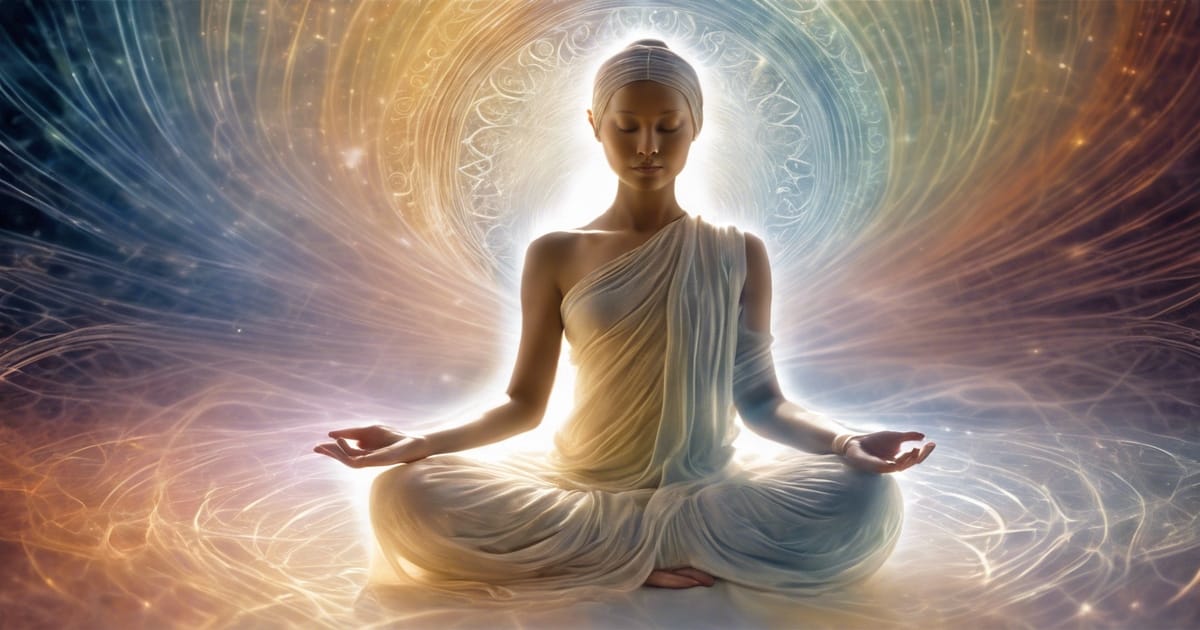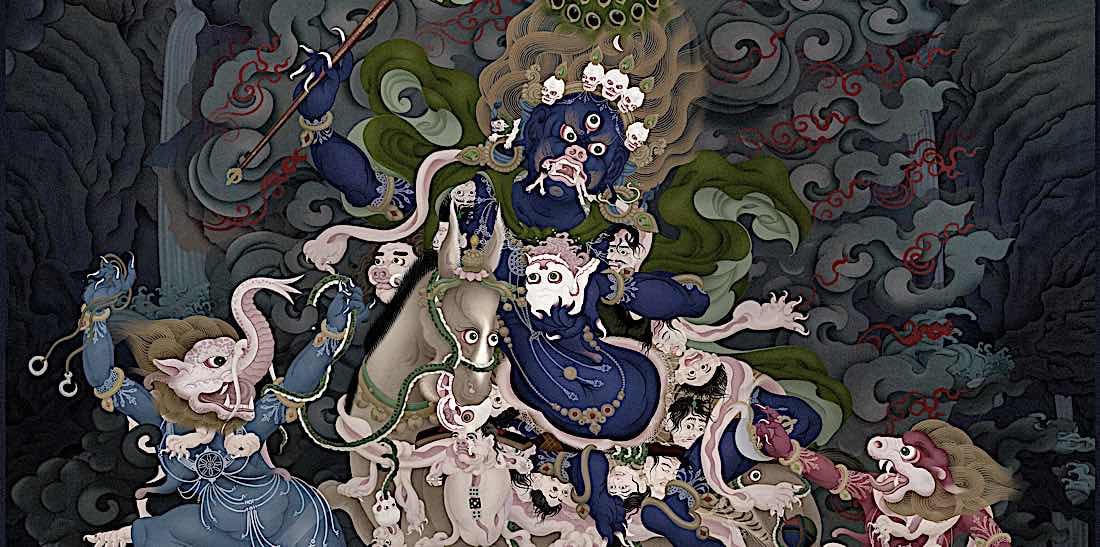Prana Meaning: Harnessing the Power of Vital Energy
The post Prana Meaning: Harnessing the Power of Vital Energy appeared first on The Yoga Nomads.

Through my yoga journey, I learned to tap into the prana energy that surrounds us all and use it to thrive and become one with the universe. The term cosmic energy represents the life force and power that flows through every living being, resonating with our souls and manifesting as subtle energy in all forms of existence.
The term “prana,” a Sanskrit word deeply rooted in the wisdom of ancient traditions and texts such as the Veda and Tantra, carries a rich tapestry of meanings, including the vital breath controlled by udana vayu.
In various cultures, prana, or life energy, is the principle that interlinks the elements of movement, food, flow, and breath as a sustaining cause in both the physical and subtle worlds.
Explored in astronomy and literature, it holds power over living beings and the mind. Our journey through yoga unravels prana’s story, including udana vayu, enhancing our comprehension of this profound energy that connects the soul and mirrors the vastness of astronomy.
Unveiling the Essence of Prana
Prana, the force of life that animates all living beings and is central to yoga, is distinct from mere breath and intricately linked to the soul and spirit.
Udana vayu, a specific aspect of pranic energy, also plays a crucial role in maintaining vitality. It is an omnipresent energy akin to the spirit, intertwined with the life processes of all living beings and woven into the fabric of nature itself, much like yoga unites body and mind.
Beyond Breath and Air
Although we often think of breathing as our life force, prana, a concept central to yoga, is not simply the air in our lungs; it is the vital energy that flows through our minds and all living beings, influencing the vitality of our cells.
Omnipresence in Nature
Every part of nature vibrates with this positive energy. Trees, animals, and even the earth are infused with life energy, resonating with the mind even in the face of death, much like a son carries on the essence of his ancestors. It connects all forms of life, making it universal.
Tracing the Roots: Origins and Etymology
Prana is deeply rooted in ancient Indian philosophy. Its etymology provides insight into its multifaceted nature.
Ancient Indian Texts
Prana’s journey begins in India’s spiritual literature. The earliest mentions of the source of life energy are found in sacred scriptures called Vedas, which also explore the son’s role and the mind’s influence.
These ancient texts, dating back thousands of years, lay the foundation for understanding the source of life’s energy and the mind’s role in contemplating death, down to the movement of electrons.
They explore prana’s role as a source connecting the mind and the physical body to higher consciousness, even as electrons flow through us until death. Here, prana is not just the breath but a source and bridge between body, mind, and electron transport in the entire body.
Sanskrit Roots
History traces the term ‘prana’ to its origins in the Sanskrit language. In Sanskrit, ‘pra’ means “to fill,” and ‘an’ signifies “movement” or “breath.”
Historical to Modern
In yoga, breathing exercises known as Pranayama aim to control this invigorating form of force, often considered the source of the mind’s energy, much like electrons are to a physical current.
Practitioners believe mastering pranayama can lead to a source of enhanced vitality and mental clarity, channeling the mind’s electrons.
Ayurveda views prana as central to balancing bodily functions. It categorizes food, activities, and herbs based on their ability to enhance or diminish one’s life energy, which is often equated with the mind’s vitality.
This Ayurvedic philosophy taps into the source of our well-being by aligning with the movement of electrons in our body.

Pranayama: Breathing Life into Prana
Pranayama is a yoga routine that harnesses the conquest of the senses and the mind, controls breath as the source of life energy, and channels electrons for vitality enhancement.
This mind-calming technique involves various breathing exercises, each with distinct health benefits and acting as an energy source, much like electrons in a circuit.
Understanding Pranayama
Pranayama, the source of vital breath control, comes from Sanskrit, where “prana” means life energy akin to electrons in action, and “ayama” means control.
Key Breathing Techniques
There are several pranayama techniques, each with a unique approach to managing breath.
Anulom Vilom: Alternating nostril breathing for balance. Kapalabhati: Forceful exhalation to cleanse and energize. Bhastrika: Bellows breath for invigorating the body. Ujjayi: Ocean-sounding breath to calm the mind.These methods, acting as a source of balance, involve inhalation, exhalation, and breath retention in varying patterns, much like electrons flow in a current.
If you need clearer instructions, watch this video to perfect your daily pranayama routine.
Vitality Through Breathwork
Regular pranayama workout leads to increased vitality:
Enhances oxygen supply Improves respiration efficiency Boosts energy levels throughout the dayHealth Benefits Galore
The health advantages of pranayama are extensive:
Reduces stress by calming the nervous system Helps in better sleep quality through relaxation Aids digestion by stimulating abdominal muscles during deep breathing Strengthens respiratory muscles, leading to improved lung functionResearch shows consistent practice can also lower blood pressure and improve heart rate variability.

Prana and the Mind’s Connection
Prana affects our mental well-being and emotions. Mindfulness can help regulate this vital energy.
Prana Influences Emotions
Prana is not just breath; it’s a life force. This energy impacts our feelings and thoughts. When prana flows freely, we feel energetic, calm, and happy. But if it’s blocked or imbalanced, we might feel anxious or sad.
Think of prana like water in a river. If the river flows without obstacles, everything is fine. But when there’s a blockage, things can go wrong.
Mindfulness Manages Prana
Mindfulness means paying attention to the present moment. It helps us understand our body’s pranic movement. We learn to control our minds (manas) and emotions through mindfulness meditations. This can lead to a more balanced state of being.
Breath Boosts Cognition
Concentrating on breathing has immense benefits for the brain, too. Deep breathing during meditation improves oxygen supply to the brain, which boosts cognitive function – that’s how well your brain works when you’re thinking or learning new things.
It’s like giving your brain fresh air; it helps clear up foggy thoughts so you can think more clearly.
Vayus: Directing the Pranic Currents
Yogic philosophy identifies pathways for directing life energy, or prana, through different vayus or winds. Each vayu is associated with specific functions and regions within the body.
Five Principal Vayus
In yogic texts, five principal vayus are the ones that matter. These winds represent the vital body of this philosophy and are essential for health and spiritual development.
Prana Vayu: Life Force
Prana vayu is considered the primary wind that performs vital functions. It resides in the chest area and is responsible for breathing and heart function. This vayu governs intake, like inhalation, swallowing, and the absorption of nutrients.
Apana Vayu: Downward Movement
Located in the lower abdomen, apana vayu manages elimination. It oversees processes such as excretion, menstruation, and childbirth. A balanced apana ensures physical and emotional release.
Samana Vayu: Balancing Air
This vayu sits near the navel center. Its role is to assimilate food and experiences evenly throughout the body. Proper digestion of both food and thoughts relies on its equilibrium.
Udana Vayu: Upward Flow
Udana vayu operates from the throat upwards to the head. It influences speech, growth, self-expression, and effort towards spirituality. Mastering it enhances vocal clarity and thought articulation.
Vyana Vayu: Outward Movement
Vyana pervades the whole body; it coordinates movement and circulation. It integrates all other vayus’ functions harmoniously into one’s being—ensuring that vigourious spreads throughout every limb.

Chakras: Harnessing the Pranic Centers
Chakras are centers where energy accumulates and flows in the human body. Each of the seven primary chakras is associated with different aspects of our physical, emotional, and spiritual health.
Energy Accumulation
The concept of chakras is that they are energetic focal points rather than physical entities. They function as spinning wheels that draw in “prana” – the life force that circulates throughout our body.
When these centers are balanced, prana flows freely, leading to a sense of well-being.
Seven Primary Chakras
The spine serves as a pillar for seven chakras, each located at specific points along its axis. Starting from the base of the spine to the crown of the head, these energy channels align vertically:
Root Chakra (Muladhara) Sacral Chakra (Svadhisthana) Solar Plexus Chakra (Manipura) Heart Chakra (Anahata) Throat Chakra (Anahata) Third Eye Chakra (Ajna) Crown Chakra (Sahasrara)If you’re curious to learn more, check out this article on The 7 Chakra Colors and Their Meanings.
The Five Pranas: Vital Energies Defined
Understanding Primary Life Forces
The human body is animated by five primary life forces known as pranas. Each has a distinct role and function.
Apana: The Downward Energy
Apana is the vital force responsible for elimination. It governs the body’s downward and outward movement of energy, aiding in excretion, menstruation, and childbirth.
This vital energy ensures that waste materials are efficiently expelled from the system.
Udana: Upward Vitality
Udana controls upward movements like speaking, swallowing, and releasing energy through the top of the head. It’s associated with growth and self-expression.
When balanced, individuals may experience clear communication skills and a sense of vitality.
Prana: Life’s Breath
Prana is often considered synonymous with life itself. It directs inward-flowing energy that governs respiration, heart function, and overall vitality. This “vital air” sustains life by ensuring oxygen reaches every cell.
Samana: Balancing Force
Samana regulates digestion and metabolism, harmonizing nutrient absorption and distribution for robust health and energy efficiency.
Vyana: Circulatory Energy
Vyana supports circulation throughout the body’s channels. It helps distribute nutrients and energy from food to all areas needing nourishment. Proper vyana function contributes to a strong immune system and physical coordination.
If you want to gain a deeper understanding of energy healing, consider joining Donna Eden’s Energy Medicine program and discover a roadmap to balance every aspect of your life. You will unlock new gifts, achieve self-mastery, and gain tools to heal anytime life throws you off balance.
Prana in Daily Practice: Techniques and Tips
Daily Exercises
Developing an awareness of pranic energy starts with basic techniques. Deep abdominal breathing is a cornerstone of this practice.
Sit or lie down comfortably. Inhale deeply through your nose, allowing your abdomen to rise more than your chest. Exhale slowly and feel the release of tension.
This type of breathing can increase awareness of pranic flow within minutes.
Mindful Breathing
Incorporate mindful breathing into routine tasks effortlessly. While walking, synchronize your breath with your steps—inhale for four steps, then exhale for the next four.
Eating becomes a meditative act when you take deep breaths between bites, savoring each flavor and being present in the moment.
Consistent Practice
The key to maintaining energetic balance is consistency in practice. Even on busy days, dedicate moments for pranayama rituals—early morning or before sleep are ideal times.
Pranayama Techniques
Pranayama refers to yogic practices that regulate breath to enhance life energy. Simple methods like Nadi Shodhana (alternate nostril breathing) can be learned quickly:
Sit comfortably with a straight back. Place your left hand on your knee. Use your right thumb to close off your right nostril. Inhale deeply through the left nostril. Close it with your ring finger; exhale through the right nostril. Continue alternating for several cycles.This exercise calms the mind and equalizes the flow of prana on both sides of the body.
Yogic Practices Integration
Yogic practices extend beyond breath control—they include movement and meditation as well:
Sun Salutations warm up the body while syncing movement with breath. Yoga poses (asanas) build strength and flexibility, enhancing pranic circulation. Meditation focuses attention inward, cultivating an intimate understanding of one’s own energy field.Conclusion
Prana, the vital force of life, can transform our holistic well-being. I am overjoyed to have had the chance to share my knowledge on this topic with you, as it has truly changed my life.
This article sheds light on its historical roots and its immense impact on mental and physical health. It also provides practical tips for integrating pranic techniques into daily life, inspiring us to live a more fulfilling and vibrant life.
By embracing Prana’s principles, transformative health benefits can be achieved. Explore the practices outlined here to harness the power of prana and experience positive shifts in your holistic health.
Frequently Asked Questions
What is the literal meaning of prana?
In Sanskrit, the word prana is derived from the root word “pra,” which means to fill or saturate, and “an,” meaning movement or breath. Prana is often translated as “life force” or “vital energy” and is believed to be the fundamental energy or essence that sustains life and consciousness in all living beings.
What is the feeling of prana?
Prana is an incredible power you might have experienced during a Yoga class without even realizing it! This energy can manifest as a strong electric charge, invigorating your body and enabling you to find comfort and ease in even the most challenging postures. It can also feel like a pure, unobstructed ‘flow’ that envelops your entire being as you move.
How do I activate prana energy?
One of the most effective ways to increase prana is to have a consistent pranayama practice. Pranayama is a set of breathing exercises that help to regulate and balance the flow of prana in the body. It involves inhaling pure fresh air deeply into the lungs and exhaling completely, which helps to remove any stale air or toxins from the body.

 JaneWalter
JaneWalter 
































